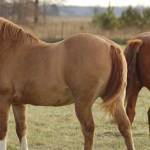Cresty Necks in Horses May Be Seasonal

Even if they are provided with what seems to be an adequate diet, many horses tend to lose some weight during the winter months. Cold stress and a lack of fresh forage may lead to this reduction in body weight, and most horses return quickly to their previous body condition when spring grass begins to grow.
Overweight horses are at a higher risk for some health problems than their thinner pasturemates. Obese equines, and even some that are of a normal body weight, may develop a ridge of fat along the top of the neck, and a high “cresty neck” score is a hallmark of certain metabolic conditions such as insulin resistance and equine metabolic syndrome. In particular, ponies with a history of laminitis are likely to have scores of 3 to 5 on a scale that can range from 0 (no evidence of a fatty crest) to 5 (very large crest that tips to one side because of excessive weight).
While common sense might point to the assumption that losing body weight would also reduce a horse’s cresty neck score, this was not the finding of researchers who studied 96 horses in the U.K. Their research showed that crests tended to be somewhat larger at the end of winter than at the end of the previous summer. Specifically, though only one-third of the horses in the group had a score of 3 to 5 at the end of the summer, just over 45% of the horses fell into this scoring range at the end of the winter. No complete explanation was found for this unexpected result.








